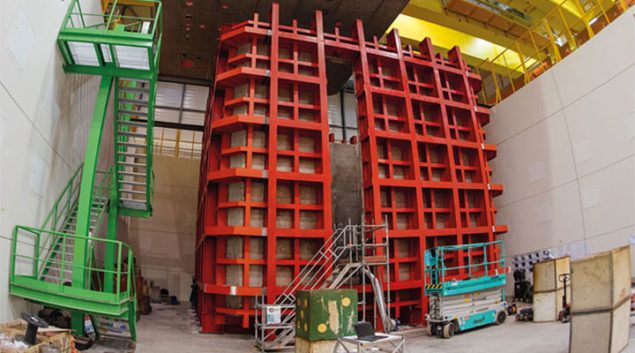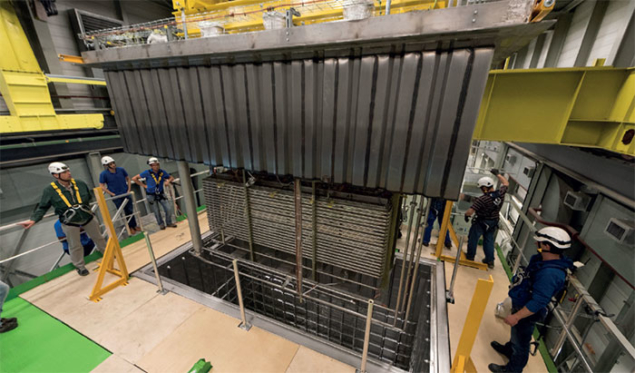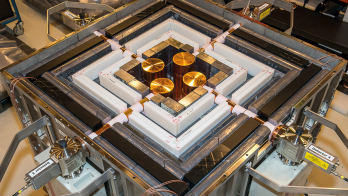CERN makes rapid progress toward prototype DUNE detectors.


Image credit: M Brice/CERN.
This 11 m-high structure with thick steel walls will soon contain a prototype detector for the Deep Underground Neutrino Experiment (DUNE), a major international project based in the US for studying neutrinos and proton decay. It is being assembled in conjunction with CERN’s Neutrino Platform, which was established in 2014 to support neutrino experiments hosted in Japan and the US (CERN Courier July/August 2016 p21), and is pictured here in December as the roof of the structure was lowered into place. Another almost identical structure is under construction nearby and will house a second prototype detector for DUNE. Both are being built at CERN’s new “EHN1” test facility, which was completed last year at the north area of the laboratory’s Prévessin site.
DUNE, which is due to start operations in the next decade, will address key outstanding questions about neutrinos. In addition to determining the ordering of the neutrino masses, it will search for leptonic CP violation by precisely measuring differences between the oscillations of muon-type neutrinos and antineutrinos into electron-type neutrinos and antineutrinos, respectively (CERN Courier December 2015 p19). To do so, DUNE will consist of two advanced detectors placed in an intense neutrino beam produced at Fermilab’s Long-Baseline Neutrino Facility (LBNF). One will record particle interactions near the source of the beam before the neutrinos have had time to oscillate, while a second, much larger detector will be installed deep underground at the Sanford Underground Research Laboratory in Lead, South Dakota, 1300 km away.

Image credit: M Brice/CERN.
In collaboration with CERN, the DUNE team is testing technology for DUNE’s far detector based on large liquid-argon (LAr) time-projection chambers (TPCs). Two different technologies are being considered – single-phase and double-phase LAr TPCs – and the eventual DUNE detectors will comprise four modules, each with a total LAr mass of 17 kt. The single-phase technique is well established, having been deployed in the ICARUS experiment at Gran Sasso, while the double-phase concept offers potential advantages. Both may be used in the final DUNE far detector. Scaling LAr technology to such industrial levels presents several challenges – in particular the very large cryostats required, which has led the DUNE collaboration to use technological solutions inspired by the liquified-natural-gas (LNG) shipping industry.
The outer structure of the cryostat (red, pictured at top) for the single-phase protoDUNE module is now complete, and an equivalent structure for the double-phase module is taking shape just a few metres away and is expected to be complete by March. In addition, a smaller technology demonstrator for the double-phase protoDUNE detector is complete and is currently being cooled down at a separate facility on the CERN site (image above). The 3 × 1 × 1 m3 module will allow the CERN and DUNE teams to perfect the double-phase concept, in which a region of gaseous argon situated above the usual liquid phase provides additional signal amplification.
The large protoDUNE modules are planned to be ready for test beam by autumn 2018 at the EHN1 facility using dedicated beams from the Super Proton Synchrotron. Given the intensity of the future LBNF beam, for which Fermilab’s Main Injector recently passed an important milestone by generating a 700 kW, 120 GeV proton beam for a period of more than one hour, the rate and volume of data produced by the DUNE detectors will be substantial. Meanwhile, the DUNE collaboration continues to attract new members and discussions are now under way to share responsibilities for the numerous components of the project’s vast far detectors (see “DUNE collaboration meeting comes to CERN” in this month’s Faces & Places).








